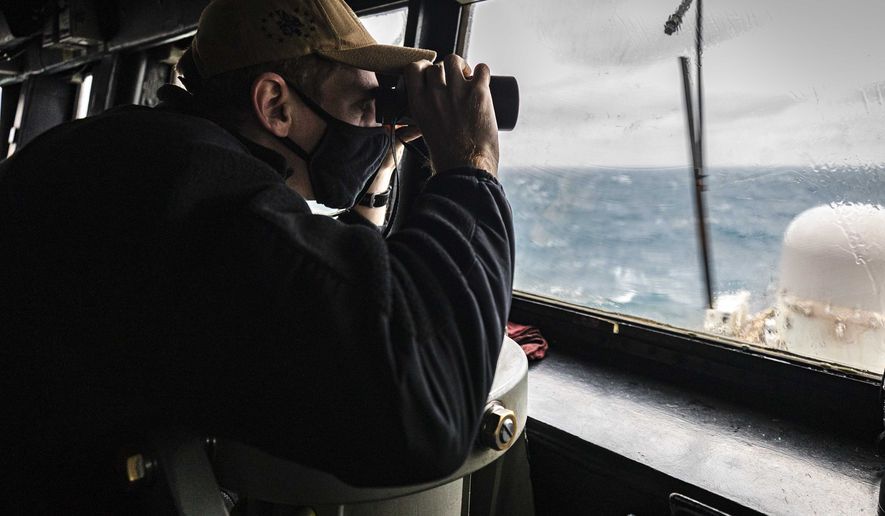A U.S. Navy guided-missile destroyer sailed through the disputed Taiwan Strait on Tuesday in the latest show of force aimed at keeping the status of the 100-mile waterway as international waters and challenge claims by China.
The USS Curtis Wilbur, an Arleigh Burke-class missile destroyer, conducted a routine passage of the strait, said Lt. Mark Langford, a spokesman for the Navy’s 7th Fleet.
“The ship’s transit through the Taiwan Strait demonstrates the U.S. commitment to a free and open Indo-Pacific,” he said. “The United States military flies, sails and operates anywhere international law allows.”
The operation was the second time in two months the Wilbur sailed through the Strait.
Navy warship transits of the strait have been conducted on nearly a monthly basis. In April, the guided missile destroyer USS John S. McCain sailed through it. The McCain also made a passage through the Taiwan Strait in February, the first time a warship operation was conducted during the new Biden administration.
Tensions remain high across the strait as China in recent months sharply increased aerial incursions into Taiwan’s air defense zone. Critics say the daily air incursions near the island are meant to coerce the Taiwan government into following mainland dictates.
The largest incursion took place June 15 when a total of 28 Chinese aircraft, including nuclear-capable bombers and J-16 fighters, entered Taiwanese air defense airspace.
Monday’s destroyer passage comes as China’s Defense Ministry has issued threats against the island state that separated from the mainland following a civil war in 1949. U.S. Navy commanders have warned that China is building up military forces to retake the island by force and may be capable of doing so in six years or less.
Joint Chiefs of Staff Chairman Gen. Mark Milley, however, said last week during a Senate hearing that China currently lacks the capabilities needed to retake Taiwan.
“I think China has a ways to go to develop the actual, no-kidding capability to conduct military operations to seize through military means the entire island of Taiwan if they wanted to do that,” Gen. Milley said.
Two weeks ago, China’s Defense Ministry criticized the United States support for Taiwan after three U.S. senators visited Taiwan aboard an Air Force C-17 transport, calling the visit “irresponsible and dangerous.”
“China must be and will be reunited. The People’s Liberation Army (PLA) will resolutely defeat any attempt by the secessionists to separate Taiwan region from China, and safeguard national unity and territorial integrity at all costs,” said Defense Ministry spokesman Sr. Col. Wu Qian.
Col. Wu said China urged the United States to halt all official exchanges and military contacts with Taiwan, and warned the ruling Democratic Progressive Party in Taiwan that “those who play with fire will only burn themselves.”
After the Wilbur’s last transit through the strait, China’s government called the operation a provocation that undermined peace and stability in the region.
The warship passages through the Taiwan Strait increased sharply during the Trump administration. Since 2017 at least 20 Navy warships have conducted passages through the Strait.
As a result the strait is no longer viewed as Chinese maritime territory but has been recognized as international waters.
China has complained that U.S. military ships and surveillance aircraft have increased significantly under the Biden administration.
Several months ago Beijing was irked by the close surveillance of China’s aircraft carrier the Liaoning by a Navy destroyer in the South China Sea. Photos released by the Navy showed officers relaxing on the deck of the destroyer with the carrier within sight.
The Chinese stated that the United States “seriously interfered” with military training activities and threatened the safety of navigation and personnel by shadowing the carrier.
Defense Intelligence Agency Director Army Lt. Gen. Scott Berrier told the Senate Armed Services Committee earlier this year that China is no longer seeking to deepen economic ties with Taiwan.
Instead, Beijing is “using military pressure to deter the island from achieving formal independence, but it has now likely hardened its position and is using military pressure tactics to coerce Taiwan into accepting China’s unification agenda,” he said.
“Beijing pressured Taipei and conducted military operations near Taiwan and Taiwan-held islands, very likely to message increased displeasure with U.S.-Taiwan ties,” he said.
“For example, the PLA Air Force and PLA Navy conducted provocative transits and military exercises near Taiwan, including entering Taiwan’s air defense identification zone and deliberately crossing the Taiwan Strait centerline — the median line of the strait that Beijing has generally respected but recently announced does not exist.”
• Bill Gertz can be reached at bgertz@washingtontimes.com.




Please read our comment policy before commenting.